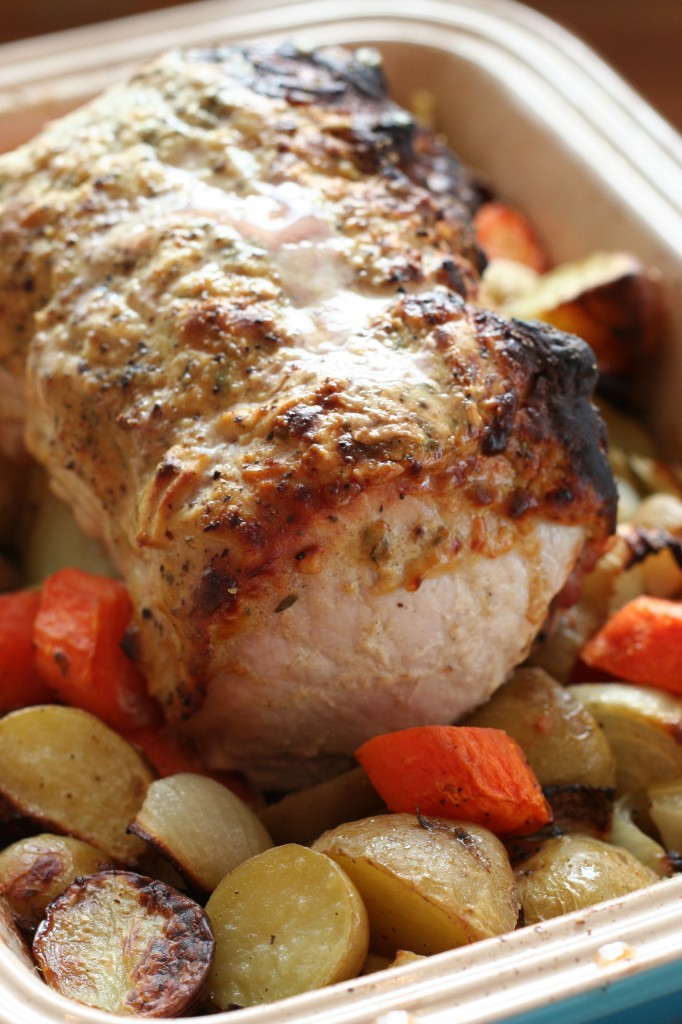For someone who loves to cook, I know it’s surprising to admit that I only cooked a pork tenderloin for the first time this past winter. I put it down to the fact that growing up, our family only ever ate the most basic cuts of meat — lots of boneless, skinless chicken breasts and minced beef, with an occasional pork chop or rump roast. But ever since Kelly wrote about how pork tenderloin is one of her favorite meats to cook and makes for a quick weeknight dinner, I’ve had it in the back of my head to (finally) try it myself.
The first time I cooked a tenderloin, I wasn’t even sure my husband had got the right cut from the butcher when he came home with it, since it didn’t look like the photo in my cookbook (turns out the fat hadn’t been trimmed or the loin tied, like the recipe stated). The second time I cooked one I made this recipe, but even though I remembered to ask the butcher to tie the tenderloin, I forgot to ask him to trim the fat. And what a mistake that was, since it meant the garlicky mustard topping was slathered over the fat instead of directly on the meat, which was a terrible waste (though we still scraped as much as we could off the fat and ate it anyway). But third time’s the charm, and I finally got it right.
I can’t recommend the sauteed cabbage highly enough — I stood at the stove picking at the buttery, salty shreds of cabbage straight from the pan while the pork was resting — but if you want to skip it, then the pork with fennel is an easy roast version of a one-pot dinner. If you can’t find fennel or don’t care for its anise flavor, just leave it out; the dish will still be delicious with just the onions, carrots and potatoes.
Roast Loin of Pork with Fennel
adapted from Barefoot Contessa Parties! by Ina Garten
Serves 6
2 cloves garlic, minced
salt and freshly ground black pepper, plus 1 tablespoon kosher salt
1 tablespoon fresh thyme leaves (or 1 teaspoon dried thyme)
1/4 cup (60 ml) Dijon mustard
1 x 3 lb (1.4 kg) boneless pork loin, trimmed of fat and tied (ask your butcher to do this for you)
3 small fennel bulbs, tops removed
8 carrots, peeled and thickly sliced diagonally
12 baby potatoes, halved or quartered, depending on size
2 large yellow onions, thickly sliced
4 tablespoons olive oil
Preheat the oven to 425°F (220°C).
With a mortar and pestle, or in a food processor fitted with a steel blade, grind together the garlic, 1 tablespoon salt, and thyme leaves. Add the mustard. Spread the mixture over the pork and allow it to sit at room temperature for at least 30 minutes.
Meanwhile, cut the fennel bulbs in thick wedges, cutting through the core. Place the fennel, carrots, potatoes, and onions in a large roasting tin or casserole dish and toss evenly with the olive oil, salt and pepper to taste. Cook for 30 minutes. Add the pork loin to the tin and continue to cook for another 30 to 50 minutes, or until a meat thermometer inserted into the middle of the pork reads exactly 138°F (59°C). Remove the meat from the pan and return the vegetables to the oven to keep cooking, if necessary. Cover the meat with aluminum foil and allow it to rest for 15 minutes. Remove the strings from the meat and slice it thickly. Arrange the meat and vegetables on a platter. Sprinkle with salt and freshly ground pepper to taste. Serve warm.
***
Sauteed Cabbage
adapted from Barefoot Contessa Parties! by Ina Garten
Serves 6
1 small head white cabbage, including outer green leaves (about 2.5 lb/1.1 kg)
2 tablespoons unsalted butter
1 1/2 teaspoons kosher salt
1/2 teaspoon freshly ground black pepper
Cut the cabbage in half and, with the cut-side down, slice it as thinly as possible around the core, as though you were making coleslaw. (Or you could cut the cabbage with the slicing attachment of your food processor.) Discard the core.
Melt the butter in a large saute pan or heavy-bottomed pot over medium-high heat. Add the cabbage, salt, and pepper and saute for 10 to 15 minutes, stirring occasionally, until the cabbage is tender and begins to brown. Season to taste and serve warm.





